A Sensitive Band to Optimize Winter Wheat Crop Residue Cover Estimation by Eliminating Moisture Effect
Abstract
:1. Introduction
2. Materials and Methods
2.1. Laboratory Experiment
2.1.1. Crop Residue
2.1.2. Soil
2.2. Data Processing
2.2.1. Preprocessing
2.2.2. Spectra and RWC Data Processing
2.3. Data Analysis Method
2.3.1. Crop Residue Cover Estimation Method
2.3.2. Improvements to Crop Residue Cover Estimation Model
2.3.3. Sensitivity Analysis of RWC and Reflectance
2.3.4. RWC Inversion by Water Indices and Sensitive Band
2.4. Validation
3. Results
3.1. Analysis of Crop Residues and Soil Spectra
3.2. Crop Residue Cover Estimation Model and Moisture Effect
3.3. Inversion of the Slope and Intercept of Model
3.4. Sensitivity Analysis of RWC and Reflectance
3.5. Inversion of RWC of Soil and Crop Residue
3.6. Inversion of RWCm
3.7. Validation
4. Discussion
5. Conclusions
Author Contributions
Funding
Acknowledgments
Conflicts of Interest
References
- Delgado, J. Crop residue is key for sustaining maximum food production and for conservation of our biosphere. J. Soil Water Conserv. 2010, 65, 111A–116A. [Google Scholar] [CrossRef]
- Jinhua, Z.; Congzhi, Z.; Jiabao, Z. Effect of Straw Returning via Deep Burial Coupled with Application of Fertilizer as Primer on Soil Nutrients and Winter Wheat Yield. Acta Pedol. Sin. 2016, 53, 438–449. [Google Scholar]
- Wang, J.; Zhang, L.; Pang, H.; Zhang, J. Returning granulated straw for accelerating decomposition rate and improving soil fertility. Trans. Chin. Soc. Agric. Eng. 2017, 33, 177–183. [Google Scholar]
- Zhang, L.; Wang, J.; Pang, H.C.; Zhang, J.T.; Guo, J.J.; Dong, G.H. Effects of short-term granulated straw incorporation on grain yield and soil respiration in a winter wheat-summer maize cropping system. J. Appl. Ecol. 2018, 29, 565–572. [Google Scholar]
- Garcia-Franco, N.; Albaladejo, J.; Almagro, M.; Martínez-Mena, M. Beneficial effects of reduced tillage and green manure on soil aggregation and stabilization of organic carbon in a Mediterranean agroecosystem. Soil Tillage Res. 2015, 153, 66–75. [Google Scholar] [CrossRef]
- Fei, L.U.; Wang, X.; Han, B.; Ouyang, Z.; Duan, X.; Zheng, H.U.; Miao, H. Soil carbon sequestrations by nitrogen fertilizer application, straw return and no-tillage in China’s cropland. Glob. Chang. Biol. 2009, 15, 281–305. [Google Scholar]
- Lal, R. Carbon Management in Agricultural Soils. Mitig. Adapt. Strateg. Glob. Chang. 2007, 12, 303–322. [Google Scholar] [CrossRef]
- Tejada, M.; Hernandez, M.T.; Garcia, C. Soil restoration using composted plant residues: Effects on soil properties. Soil Tillage Res. 2009, 102, 109–117. [Google Scholar] [CrossRef]
- Blanco-Canqui, H.; Lal, R. Impacts of Long-Term Wheat Straw Management on Soil Hydraulic Properties under No-Tillage. Soil Sci. Soc. Am. J. 2007, 71, 1166. [Google Scholar] [CrossRef]
- Guo, X.; Jing, D.; Zhou, R.; Fu, J. Detection of Phenolic Acids in Crop Straw Decomposed Liquid and Their Effect on Pathogen of Northern Leaf Blight of Corn. J. Maize Sci. 2016, 24, 166–172. [Google Scholar]
- Zhang, S.; Shi, Z.L.; Yang, S.J.; Gu, K.J.; Dai, T.B.; Wang, F.; Li, X.; Sun, R.H. Effects of nitrogen application rates and straw returning on nutrient balance and grain yield of late sowing wheat in rice-wheat rotation. J. Appl. Ecol. 2015, 26, 2714–2720. [Google Scholar]
- Zheng, B.; Campbell, J.B.; Beurs, K.M.D. Remote sensing of crop residue cover using multi-temporal Landsat imagery. Remote Sens. Environ. 2012, 117, 177–183. [Google Scholar] [CrossRef]
- Sullivan, D.G.; Truman, C.C.; Schomberg, H.H.; Endale, D.M.; Strickland, T.C. Evaluating Techniques for Determining Tillage Regime in the Southeastern Coastal Plain and Piedmont. Agron. J. 2006, 98, 1236–1246. [Google Scholar] [CrossRef]
- Qi, J.; Marsett, R.; Heilman, P.; Bieden-bender, S.; Moran, S.; Goodrich, D.; Weltz, M. RANGES improves satellite-based information and land cover assessments in southwest United States. Eos Trans. Am. Geophys. Union 2002, 83, 601–606. [Google Scholar] [CrossRef]
- Gelder, B.K.; Kaleita, A.L.; Cruse, R.M. Estimating Mean Field Residue Cover on Midwestern Soils Using Satellite Imagery. Agron. J. 2009, 101, 635–643. [Google Scholar] [CrossRef]
- Daughtry, C.S.T.; Mcmurtrey, J.E.; Chappelle, E.W.; Hunter, W.J.; Steiner, J.L. Measuring crop residue cover using remote sensing techniques. Theor. Appl. Climatol. 1996, 54, 17–26. [Google Scholar] [CrossRef]
- Daughtry, C.S.T.; Hunt, E.R.; Doraiswamy, P.C.; McMurtrey, J.E. Remote Sensing the Spatial Distribution of Crop Residues. Agron. J. 2005, 97, 864–871. [Google Scholar] [CrossRef]
- Serbin, G.; Hunt, E.R.; Daughtry, C.S.T.; McCarty, G.; Doraiswamy, P. An Improved ASTER Index for Remote Sensing of Crop Residue. J. Med. Virol. 2009, 1, 853–856. [Google Scholar] [CrossRef]
- Biard, F.; Bannari, A.; Bonn, F. SACRI (Soil Adjusted Corn Residue Index): Un indice de residus de culture de mais. In Proceedings of the 17th Canadian Symposium on Remote Sensing, Saskatoon, SK, Canada, 13–15 June 1995. [Google Scholar]
- Bannari, K.; Haboudane, D.; McNairn, H.; Bonn, F. Modified Soil Adjusted Crop Residue Index (MSACRI): A new index for mapping crop residue. In Proceedings of the IEEE 2000 International Geoscience and Remote Sensing Symposium, Honolulu, HI, USA, 24–28 July 2000. [Google Scholar]
- Biard, F.; Baret, F. Crop residue estimation using multiband reflectance. Remote Sens. Environ. 1997, 59, 530–536. [Google Scholar] [CrossRef]
- Miguel, Q.; Craig, D. Spectral Indices to Improve Crop Residue Cover Estimation under Varying Moisture Conditions. Remote Sens. 2016, 8, 660. [Google Scholar] [CrossRef]
- Quemada, M.; Hively, W.D.; Daughtry, C.S.T.; Lamb, B.T. Improved crop residue cover estimates obtained by coupling spectral indices for residue and moisture. Remote Sens. Environ. 2018, 206, 33–44. [Google Scholar] [CrossRef]
- Feng, Z.; Guang-Sheng, Z. Research progress on monitoring vegetation water content by using hyperspectral remote sensing. Chin. J. Plant Ecol. 2018, 42, 517–525. [Google Scholar] [CrossRef]
- Daughtry, C.S.T.; Serbin, G.; Reeves, J.B., III; Doraiswamy, P.; Hunt, E.R. Spectral Reflectance of Wheat Residue during Decomposition and Remotely Sensed Estimates of Residue Cover. Remote Sens. 2010, 2, 416–431. [Google Scholar] [CrossRef] [Green Version]
- Daughtry, C.S.T.; Hunt, E.R. Mitigating the effects of soil and residue water contents on remotely sensed estimates of crop residue cover. Remote Sens. Environ. 2008, 112, 1647–1657. [Google Scholar] [CrossRef]
- Chang, C.W. Near infrared reflectance spectroscopy-Principal components regression analyses of soil properties. Soil Sci. Soc. Am. J. 2001, 65, 480–490. [Google Scholar] [CrossRef]
- Fan, W.; Chen, J.M.; Ju, W.; Zhu, G. GOST: A Geometric-Optical Model for Sloping Terrains. Ieee Trans. Geosci. Remote Sens. 2014, 52, 5469–5482. [Google Scholar]
- Li, A.; Wang, Q.; Bian, J.; Lei, G. An Improved Physics-Based Model for Topographic Correction of Landsat TM Images. Remote Sens. 2015, 7, 6296–6319. [Google Scholar] [CrossRef] [Green Version]
- Li, H.J.; Liu, Z.H.; Qu, S.G.; Dong, Y.M.; Song, G.L.; Li, Z.J. Dezhou Soil Fertility Change and Analysis. Chin. Agric. Sci. Bull. 2009, 25, 134–137. [Google Scholar]
- Li, F. Succession of Upland Soil Microbial Structure under Long-Term Fertilization in Huang-Huai-Hai Plain. Ph.D. Thesis, Henan Agricultural University, Zhengzhou, China, 2018. [Google Scholar]
- Liu, M.; He, B.; Lü, A.; Zhou, L.; Wu, J. Parameters sensitivity analysis for a crop growth model applied to winter wheat in the Huanghuaihai Plain in China. Geosci. Model Dev. Discuss. 2014, 7, 3867–3888. [Google Scholar] [CrossRef]
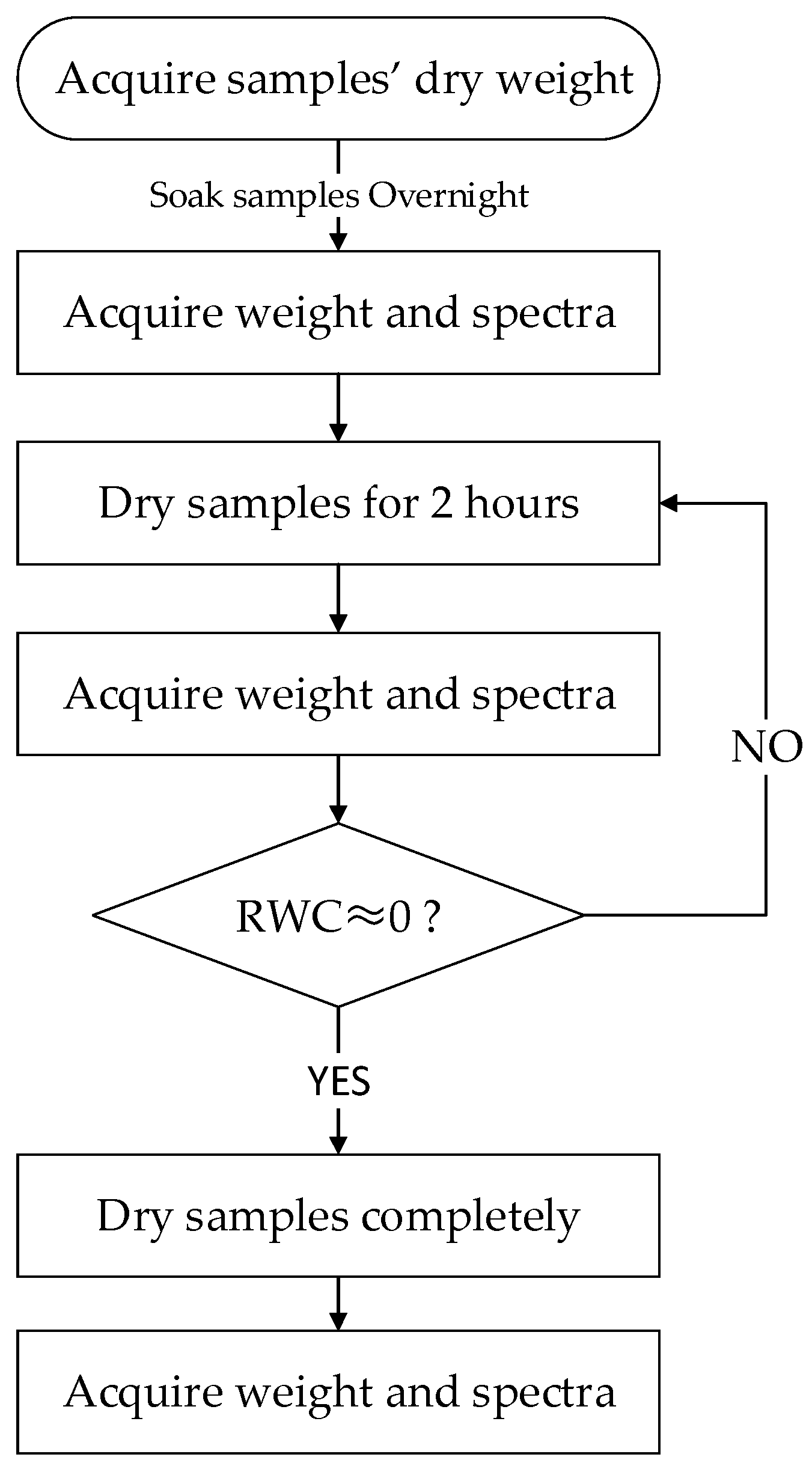
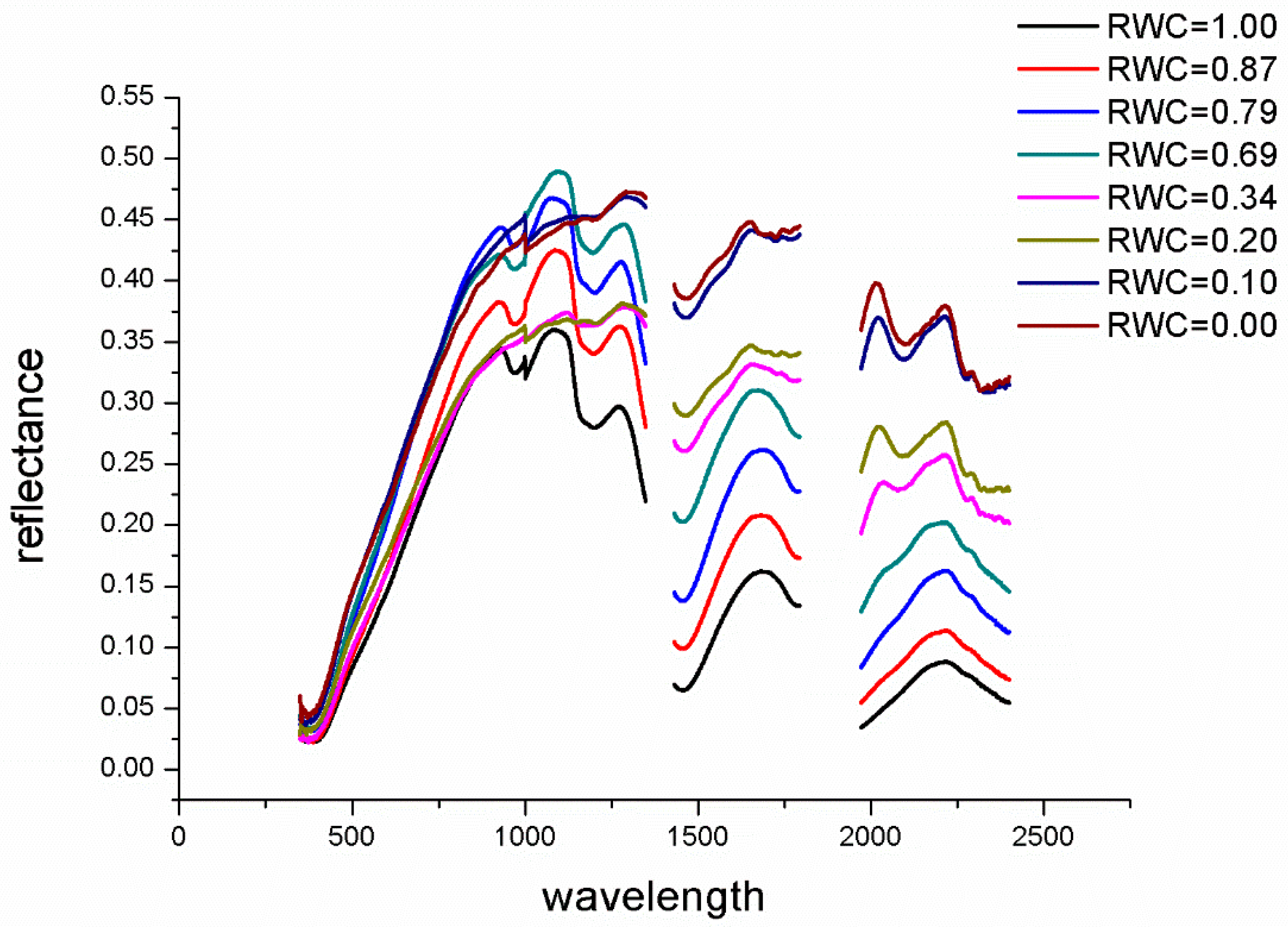
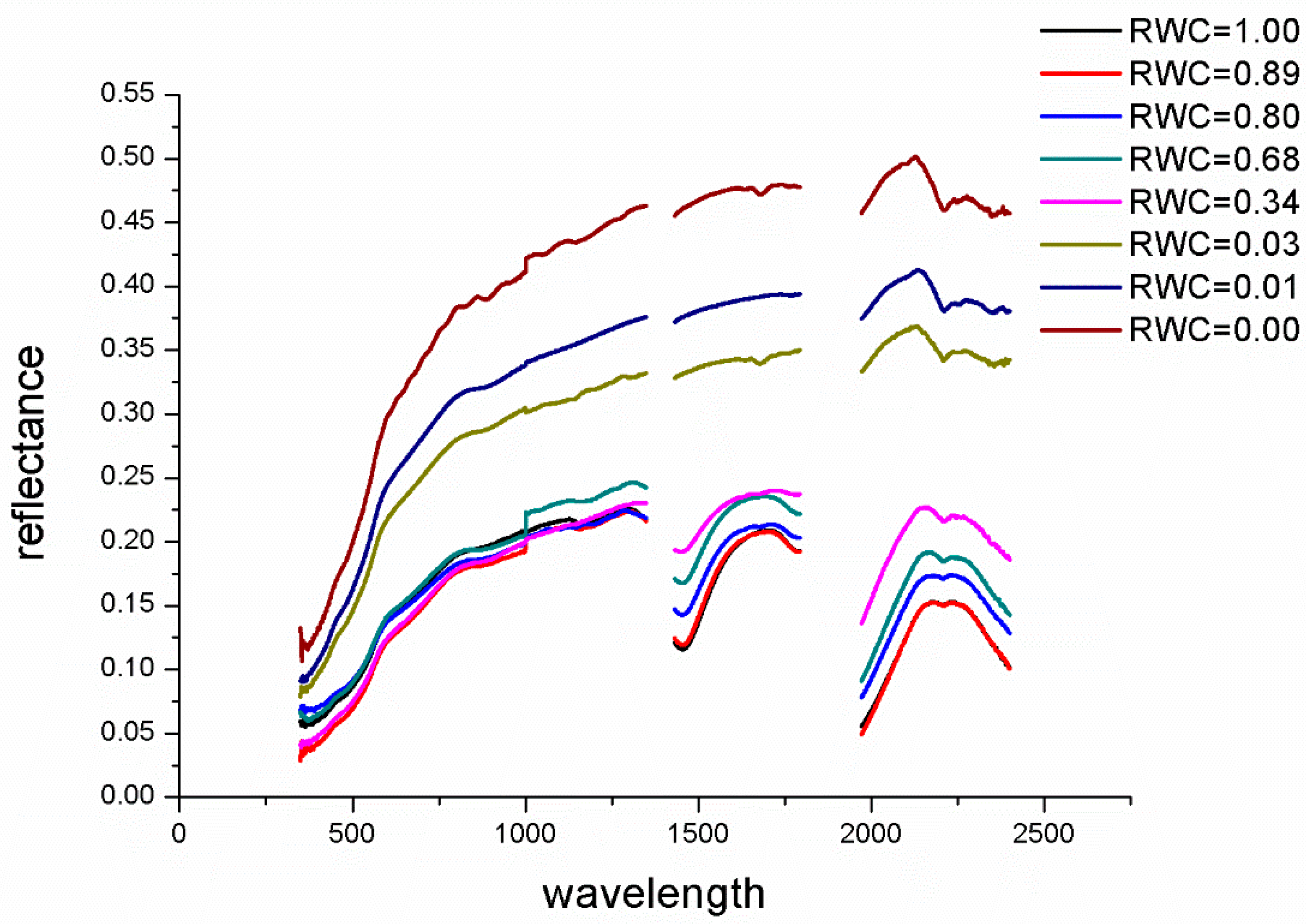



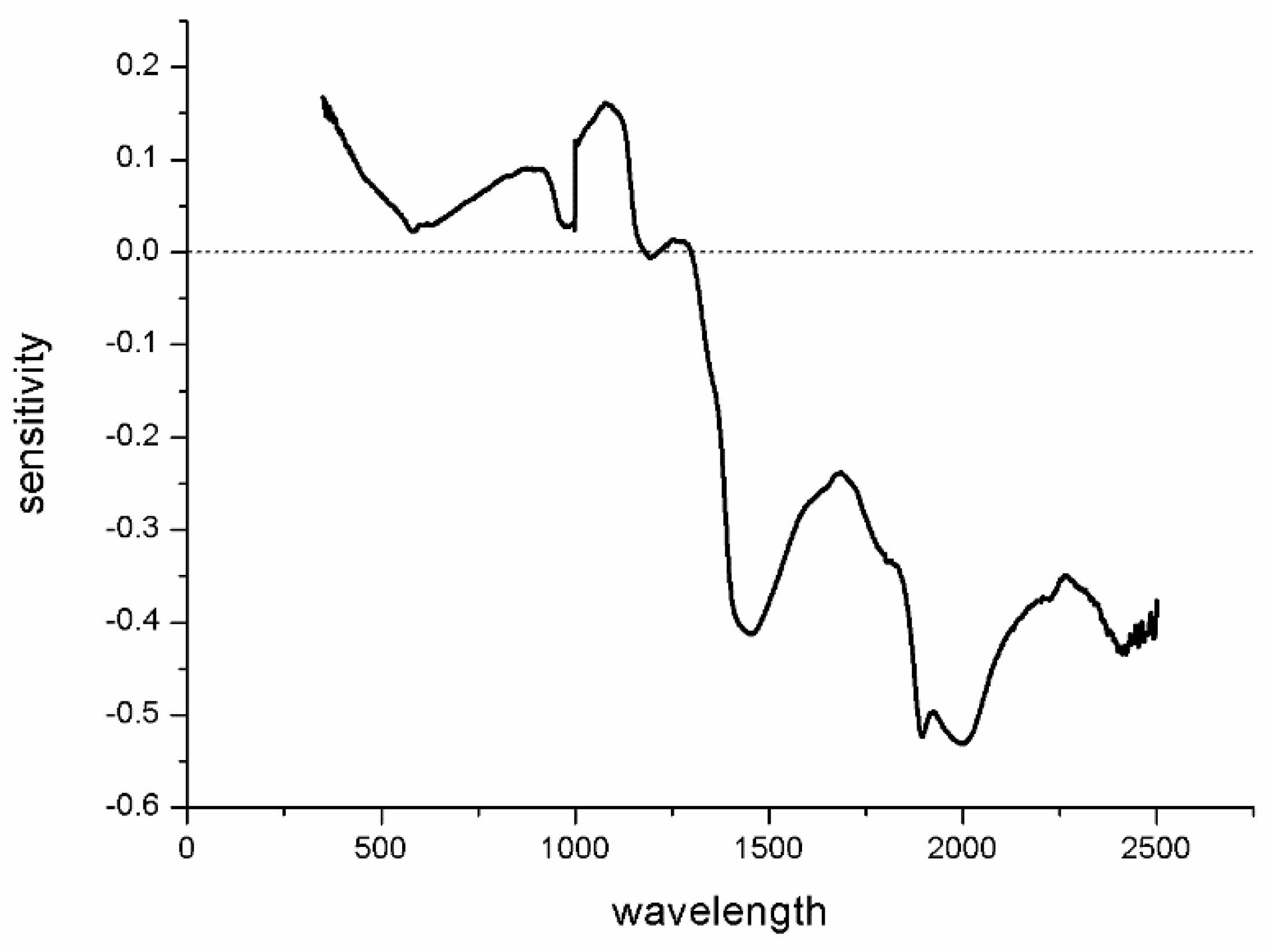

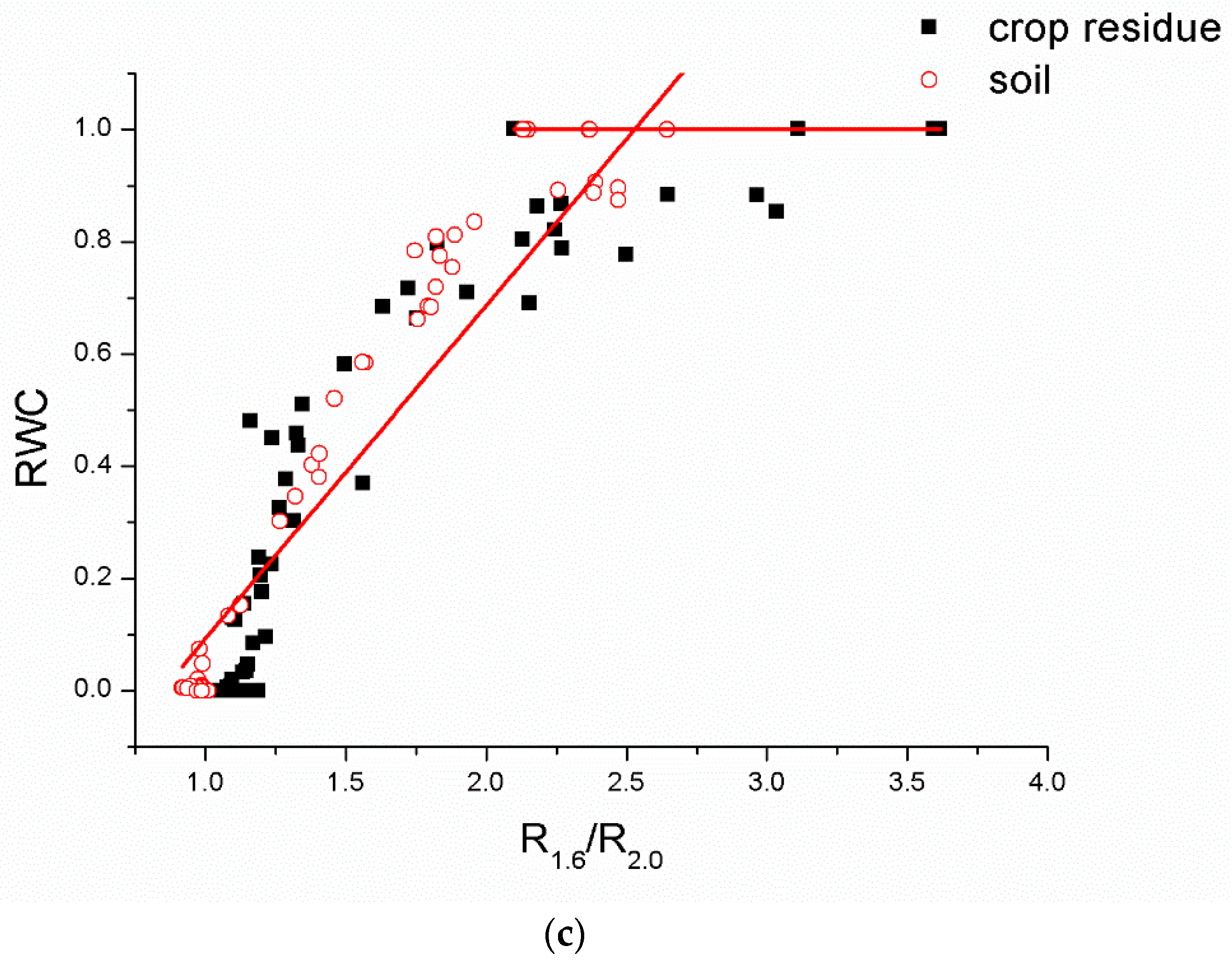




| Water Indices | The Selected Bands |
|---|---|
| is 10-nm band centered at 1500 nm, is 10-nm band centered at 1600 nm | |
| is 10-nm band centered at 1600 nm, is 10-nm band centered at 2030 nm | |
| is 10-nm band centered at 2200 nm, is 10-nm band centered at 2030 nm | |
| SWIR3/SWIR6 | SWIR3: 1640–1680 nm, SWIR6: 2185–2225 nm for WorldView-3 |
| OLI6/OLI7 | OLI6: 1570–1650 nm, OLI7: 2110–2290 nm for Landsat8 |
| Parameter | Equation | Adj.R2 | RMSE |
|---|---|---|---|
| slope | 0.99868 | 0.01268 | |
| Intercept | 0.9743 | 0.03336 |
| Water Indices/The Sensitive Band | The Selected Bands |
|---|---|
| R1.6/R1.5 | R1.5 is 10-nm band centered at 1500 nm R1.6 is 10-nm band centered at 1600 nm |
| R1.6/R2.0 | R1.6 is 10-nm band centered at 1600 nm R2.0 is 10-nm band centered at 2030 nm |
| R2005 | R2005 is 10-nm band centered at 2005 nm |
© 2019 by the authors. Licensee MDPI, Basel, Switzerland. This article is an open access article distributed under the terms and conditions of the Creative Commons Attribution (CC BY) license (http://creativecommons.org/licenses/by/4.0/).
Share and Cite
Wang, Y.; Zhao, S.; Cai, W.; Heo, J.; Peng, F. A Sensitive Band to Optimize Winter Wheat Crop Residue Cover Estimation by Eliminating Moisture Effect. Sustainability 2019, 11, 3032. https://doi.org/10.3390/su11113032
Wang Y, Zhao S, Cai W, Heo J, Peng F. A Sensitive Band to Optimize Winter Wheat Crop Residue Cover Estimation by Eliminating Moisture Effect. Sustainability. 2019; 11(11):3032. https://doi.org/10.3390/su11113032
Chicago/Turabian StyleWang, Yamei, Shuhe Zhao, Wenting Cai, Joon Heo, and Fanchen Peng. 2019. "A Sensitive Band to Optimize Winter Wheat Crop Residue Cover Estimation by Eliminating Moisture Effect" Sustainability 11, no. 11: 3032. https://doi.org/10.3390/su11113032





